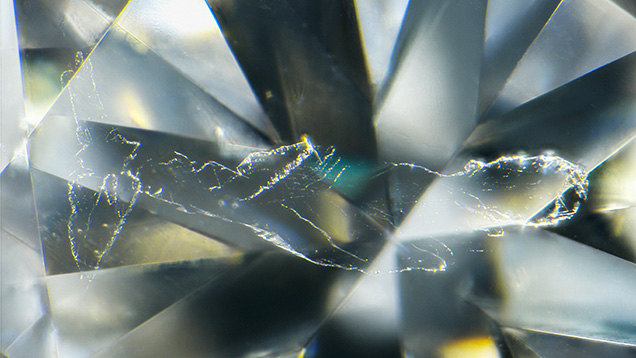Natural Diamond with Twinning Wisps Resembling a Whale

The authors recently examined a 0.46 ct type Ia round brilliant diamond with SI1 clarity that had surprisingly patterned twinning wisps. When viewed through the table, the twinning wisps resembled a whale (see above). Twin planes can form in diamond when the orientation of the crystal structure changes during growth in the earth’s mantle. Twinning wisps are atomic defects along this plane, found in ~10% of type Ia diamonds (S. Eaton-Magaña et al., “Natural-color D-to-Z diamonds: A crystal-clear perspective,” Fall 2020 G&G, pp. 318–335).
A termination of one of these features just below the pavilion was examined using photoluminescence (PL) mapping at various excitation wavelengths to examine the distribution of atomic-level defects in the crystal lattice. The PL mapping with 455 nm excitation revealed a relative increase in the defect concentrations of the nitrogen-related centers of H3 (NVN0) with zero-phonon line (ZPL) at 503.2 nm and H4 (4N+2V) with ZPL at 495.9 nm; a weak radiation-related defect, the TR12 with ZPL at 469.9 nm was also detected (A.M. Zaitsev, Optical Properties of Diamond, Springer-Verlag, Berlin and Heidelberg, 2001, and references therein). PL mapping using 633 nm excitation revealed that the GR1 (V0; ZPL at 741.2 nm) had a higher Raman-normalized peak area corresponding to the termination of the twinning wisp compared to diamond adjacent to the wisp. The GR1 defect is typically formed by radiation damage of a diamond lattice. Although the GR1 was elevated, we did not observe radiation stains around the twinning wisps. Furthermore, there were no visible changes to the color of the diamond’s fluorescence when exposed to deep ultraviolet luminescence, which can occur with significant radiation exposure.
This stone offers an example of how natural growth processes in diamond can result in microscopic features that occasionally form delightful patterns.



